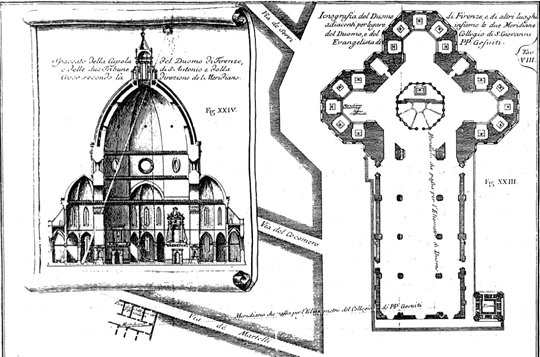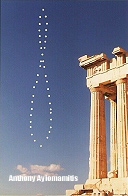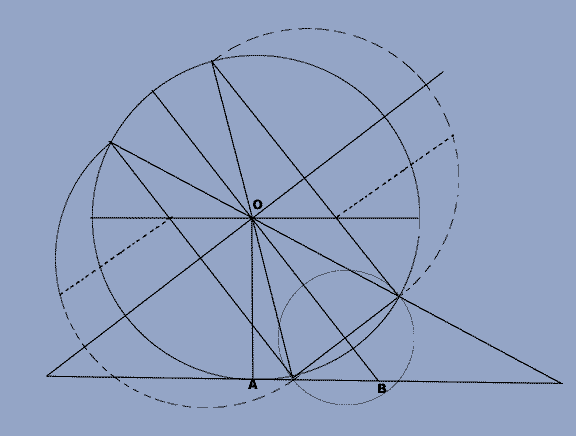Early need for determining the vernal equinox
During the Medieval Age the monasteries kept astronomy alive. Astronomy was taught by the Church primarily to compute the date of Easter so that all Christians throughout the word could celebrate on the same day as decreed by the bishops of Gaul, 314 A. D.. The best way to determine the date is to determine the exact date of the equinox. The date of Easter is the first Sunday after the first full (Paschal) Moon after the vernal equinox. This date was chosen so that Easter would never fall on the Jewish Passover, 14 Nissan (first month of the new year which began after the vernal equinox).
Renaissance Cathedrals
 The Catholic Church provided the means and encouraged improvements for the measurement of the vernal equinox. Paolo del Pozzo Toscanelli, in 1475, designed the first meridiana in the cathedral of Santa Maria del Fiore, Florence, Italy. He laid down a geographical North/South line (meridiana) and "pierced the lantern" (a hole in the ceiling) which acted as a gnomon. When the spot of sunlight crossed the meridiana it was noon and when it reached a certain point along the line from north to south, the date of the equinox was determined. For a long time the meridiana was known as "the most beautiful monument to astronomy in the world" and it was said that "it was the greatest instrument of astronomy." Many more meridiana were constructed; of special mention is that of San Petronio, Bologna, Italy.
The Catholic Church provided the means and encouraged improvements for the measurement of the vernal equinox. Paolo del Pozzo Toscanelli, in 1475, designed the first meridiana in the cathedral of Santa Maria del Fiore, Florence, Italy. He laid down a geographical North/South line (meridiana) and "pierced the lantern" (a hole in the ceiling) which acted as a gnomon. When the spot of sunlight crossed the meridiana it was noon and when it reached a certain point along the line from north to south, the date of the equinox was determined. For a long time the meridiana was known as "the most beautiful monument to astronomy in the world" and it was said that "it was the greatest instrument of astronomy." Many more meridiana were constructed; of special mention is that of San Petronio, Bologna, Italy.
The Cathedrals as observatories
The height of the cathedral as an observatory was from 1650 to 1750. These observatory meridiana enabled instruments to be corrected for atmospheric refraction, determined the center of the Earth parallax, measured aberration of starlight, studied nutation of Earth's axis, recorded changes in the inclination of Earth's axis, made improvements to the calendar as well as providing better dates for winter/summer solstice and vernal/autumnal equinox. It also provided local towns a means of telling time by ringing a bell at noon. Clocks were set to sun time (a good way to encourage attendance) which constantly changed from day to day.
Introduction of the 19th Century Analemma
 With the development of trains and the need for their schedules to be universal as well as the need for nautical tables that utilized mean time from the newly developed chronometers, sun time fell out of use. By the end of the 18th century, the analemma figure eight curve we all are familiar with was being added to the meridiana so that mean time could be determined from Sun time. The figure eight curve corrected Sun time to mean time. When the Sun spot in a cathedral or a shadow from a gnomon arrives at the figure eight curve superimposed on the 12 o'clock hour, it is noon, mean time. The Sun could now easily be used to determine mean time. [For example photographer Anthony Ayomamitis set his camera to photograph the sun at noon each week throughout the year. The result is a stunning illustratiion of the solar analemma.]
With the development of trains and the need for their schedules to be universal as well as the need for nautical tables that utilized mean time from the newly developed chronometers, sun time fell out of use. By the end of the 18th century, the analemma figure eight curve we all are familiar with was being added to the meridiana so that mean time could be determined from Sun time. The figure eight curve corrected Sun time to mean time. When the Sun spot in a cathedral or a shadow from a gnomon arrives at the figure eight curve superimposed on the 12 o'clock hour, it is noon, mean time. The Sun could now easily be used to determine mean time. [For example photographer Anthony Ayomamitis set his camera to photograph the sun at noon each week throughout the year. The result is a stunning illustratiion of the solar analemma.]
Reason for the Analemma
Earth is both tilted on its axis 23° 21' 19" and revolves around the Sun in an elliptical orbit causing a constant change in its velocity. As a result the Sun can be ahead of mean time by as much as 16 minutes and behind by 14 minutes at different times of the year. Mean time was officially adopted around 1834.
A Different Analemma
Analemma, as defined in Webster's New Universal Unabridged Dictionary, Gr.,L., "is a projection of the sphere made by straight lines, circles, and ellipses on the plane of a meridian." This in no way describes the figure eight curve, what I refer to as the 19th Century analemma.
Vitruvius, 70 B.C.-25 B.C., wrote Ten Books on Architecture describing in detail many Greek achievements in science and astronomy. In book IX, dealing with astronomy and time; chapter 7 is devoted to sundials and an elaborate description of a Greek analemma that fits the description in quotations above. The Greek word lemma, as used in mathematics, is defined as "a secondary proposition demonstrated or assumed for the purpose of being used in the demonstration of some other proposition;" ana is Greek for up, upon or according to. We have hear a completely different kind of analemma.
 Vitruvius, working from earlier Greek manuscripts now lost, constructs the analemma from the known height of a gnomon and the known length of its equinox shadow. The result of the geometric construction is a projection of the winter and summer solstice shadow lines (known as the zodiacal plaques) and the vernal and autumnal shadow lines. To complete the design of the sundial a further projection, constructed 90 deg to the meridian, provides added day and hour lines for the entire year.
Vitruvius, working from earlier Greek manuscripts now lost, constructs the analemma from the known height of a gnomon and the known length of its equinox shadow. The result of the geometric construction is a projection of the winter and summer solstice shadow lines (known as the zodiacal plaques) and the vernal and autumnal shadow lines. To complete the design of the sundial a further projection, constructed 90 deg to the meridian, provides added day and hour lines for the entire year.
All Hours not the same Length
It is interesting to note that the Greeks divided the day in twelve hours of Sun light and twelve hours of darkness. This meant that summer hours were longer than winter hours. The geometry of the analemma allowed this accommodation.
There is a drawing in a publication by Cassini, the noted Italian/French astronomer, entitled Meridiana, 1695, which portrays the Greek analemma superimposed on the cathedral of San Petronio, Bologna, Italy. Christoph Clavius, 1537-1612, the German astronomer who reformed the Julian calendar which at his time was 11 days ahead of the vernal equinox; (there was a gain of 3 days every 400 years). This was under Pope Gregory XIII so the calendar we use today, virtually through the world, is known as the Gregorian calendar. It is he, Clavius, who said "it is incredible how many and varied are the uses of analemmas in astronomy."
Charles H. Olin, President
Principal Sources:
- ASTRONOMIES and CULTURES in EARLY MEDIEVAL EUROPE, Stephen C. McCluskey, Cambridge University Press, 1998.
- The Sun in the Church, J. L. Heilbron, Harvard University Press, 1999.
- The HISTORY and PRACTICE of ANCIENT ASTRONOMY, James Evans, Oxford University Press, 1998.









